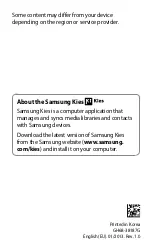
No
t fo
r C
om
me
rci
al
Us
e
Er
ics
so
n M
ob
ile
Co
mm
un
ica
tio
ns
AB
Safe and Efficient Use
79
* Examples of radio-frequency exposure guidelines
and standards that Ericsson mobile phone models are
designed to conform to:
•
ICNIRP, “Guidelines for limiting exposure to time-
varying electric, magnetic, and electromagnetic fields
(up to 300 GHz)”, International Commission on Non-
Ionizing Radiation Protection (ICNIRP), Health
Physics, vol.74, pp494-522, April 1998.
•
99/519/EC, “Council Recommendation of 12 July
1999 on the limitation of exposure of the general
public to electromagnetic fields (0 Hz to 300 GHz)”,
Official Journal of the European Communities, 1999.
•
IEEE C95.1- 1991, “Safety levels with respect to
human exposure to radio frequency electromagnetic
fields, 3 kHz to 300 GHz”, The Institute of Electrical
and Electronics Engineers Inc. (IEEE).
•
FCC Report and Order, ET Docket 93-62, FCC 96-
326, Federal Communications Commission (FCC),
August 1996.
•
Radiocommunications (Electromagnetic Radiation
Human Exposure) Standard 1999, Australian
Communications Authority (ACA), May 1999.
Driving
Please check if local laws and/or regulations, in the
country/state where you are, restrict the use of mobile
phones while driving. Law in many countries/states
requires drivers to use a Hands Free solution. If so, it
is recommended that you use Ericsson Portable
Hands Free (HPB-10) only with this Ericsson mobile
phone while driving.
Ericsson is concerned about your safety. Always
give full attention to driving and pull of the road and
park before making or answering a call if driving
conditions so require.
RF energy may affect some electronic systems in
motor vehicles such as car stereo, safety equipment
etc. In addition, some vehicle manufacturers do not
allow use of mobile phones in their vehicles, unless a
handsfree kit with an external antenna supports the
installation. Check with your vehicle manufacturer’s
representative to be sure that your mobile phone will
not affect the electronic systems in your vehicle.















































